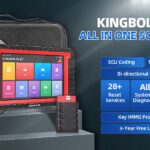A 2015 Chevy Traverse, salvaged after a flood, presented with multiple OBD2 codes after being revived. This guide outlines the codes encountered – P135A, P135B, P1682, and P0443 – and offers potential solutions for clearing them.
Understanding the OBD2 Codes on Your Chevy Traverse
After successfully starting a flood-damaged 2015 Chevy Traverse, four “permanent” OBD2 codes were encountered. Let’s break down each code:
- P135A – Ignition Coil Supply Voltage Circuit Bank 1: This code indicates a problem with the voltage supply to the ignition coils on engine bank 1.
- P135B – Ignition Coil Supply Voltage Circuit Bank 2: Similar to P135A, this code points to a voltage supply issue for the ignition coils on engine bank 2.
- P1682 – Ignition 1 Switch Circuit 2: This code suggests a problem with the ignition switch circuit, specifically circuit 2. This could be related to the wiring, the ignition switch itself, or a related component.
- P0443 – Evaporative Emission (EVAP) Purge Solenoid Valve Control Circuit: This code signifies a problem with the EVAP system, specifically the purge solenoid’s control circuit. While the solenoid itself was confirmed working, the issue likely lies in the wiring or control module.
Addressing “Permanent” OBD2 Codes
“Permanent” OBD2 codes indicate that the issue has been detected multiple times and the vehicle’s onboard diagnostic system has stored it in long-term memory. Clearing these codes often requires more than just using a standard OBD2 scanner.
Potential Solutions for Clearing Traverse OBD2 Codes
Here are potential solutions for addressing these specific codes:
For P135A and P135B:
- Inspect Wiring and Connectors: Thoroughly examine the wiring harnesses and connectors associated with the ignition coils on both engine banks for damage, corrosion, or loose connections caused by the flood.
- Check for Ground Issues: Ensure all ground connections related to the ignition system are clean and secure.
For P1682:
- Inspect Ignition Switch Circuit: Examine the wiring and connectors related to the ignition switch for damage or shorts.
- Test Ignition Switch: Test the functionality of the ignition switch itself to rule out a faulty switch.
For P0443:
- Inspect EVAP System Wiring: Check the wiring and connectors of the EVAP system, focusing on the purge solenoid control circuit, for any damage or corrosion. This includes checking the wiring between the solenoid and the ECM.
- Check for Vacuum Leaks: Inspect the EVAP system for vacuum leaks that could be affecting the purge solenoid’s operation.
Clearing the Codes After Repairs
After performing the necessary repairs, attempt to clear the codes using an OBD2 scanner. If the codes persist, a more advanced scan tool capable of clearing permanent codes might be required. In some cases, a certain number of drive cycles without the issue reoccurring may be needed before the codes will automatically clear.
Additional Considerations
Given the vehicle’s flood history, thoroughly inspecting all electrical components and connections is crucial. Residual moisture and corrosion can cause ongoing electrical problems. Consult a qualified mechanic specializing in flood-damaged vehicles if you encounter further difficulties.
Conclusion
Clearing “permanent” OBD2 codes in a flood-damaged Chevy Traverse requires a systematic approach to diagnose and repair the underlying issues. By addressing each code individually and thoroughly inspecting all related components, you can successfully resolve these problems and pass inspection. Remember, persistent issues may require professional assistance.

